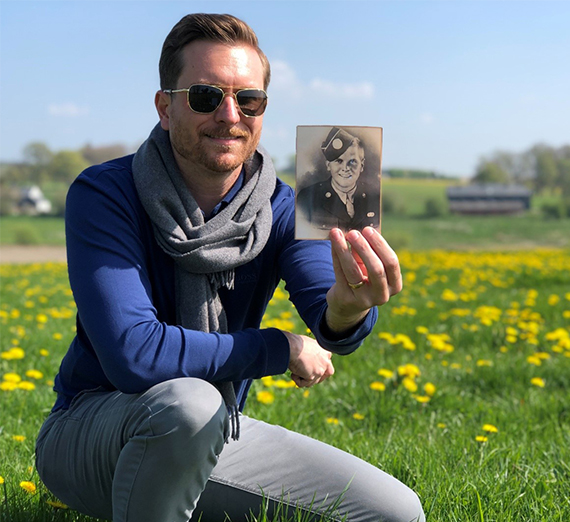Retracing the Steps of a Young Soldier

Grad Travels the Steps of His Uncle's Last Days
Seventy-nine years ago – perhaps on a similar moody morning – Constantino's great-uncle, Sgt. Thomas Butcher, was one of nearly 80,000 U.S. troops to die in the Battle of the Bulge.
In what he calls the trip of a lifetime, Constantino, who studied criminal justice and international studies major at Gonzaga while performing ROTC duties, retraced the last four days of the uncle who died in service at just 20 years old.
The journey took him from Paris through the Province of Champagne to the Ardennes, into Belgium to Bastogne then on to the small village of Bizory and surrounding fields. Butcher was a squad leader in the 2nd Platoon, Easy Company, 502nd PIR, 101st Airborne. The only son to a prominent San Francisco family of English and German heritage, he was remembered as strong, handsome and wise. He was a popular leader; soldiers trusted him to get the job done and bring his men back from patrols.
Butcher died the night of Dec. 22, under a barrage of artillery fire. Through books that chronicle Butcher’s service, Constantino learned that his uncle had become a target for artillery fire after effectively suppressing enemy advances from his machine gun position over the two preceding days.
“I got to walk in those very same fields and roads. I felt the soil, smelled the air, analyzed the terrain,” Constantino says. “While the fog cleared by afternoon, it gave me the same experience that those storied veterans faced 79 years ago. Like them, I could barely see more than a few meters ahead of me. Interestingly enough, many of the stone barns in the area still show damage from bullets and artillery.”
An Army Reserve major, graduate of U.S. Army’s elite Ranger School and former infantry officer with deployments to Afghanistan, Constantino says the experience gave him a unique understanding of small-unit tactics. He observed how Sgt. Butcher’s company held the line between Bizory and Neff, the eastern edge of the Bulge on high ground that would have been the perfect spot for a machine gun position. He believes this was likely the area where his great-uncle ultimately died.

He even found the small stone chapel that served as his great-uncle’s command post and aid station, still standing. The chapel remains unchanged, except that it now holds a photo of Butcher, which Constantino brought with him on the journey.
Butcher’s sister, Claire Constantino (née Butcher) of Burlingame, California, honored her only brother by naming her second oldest son, Thomas, after him. Thomas Constantino, who passed away in 2018, had risen to the rank of colonel in the Marine Corps. He had also served on multiple educational boards, including the U.S. Naval Academy Admissions Board.
“Veterans Day is about honoring the military personnel whose patriotism and love of country lead them to serve and sacrifice for our common good,” Constantino notes. “I am keeping my great uncle’s memory alive by undertaking this journey and rediscovering the past. It’s the least I can do to honor the sacrifices he made.”
Butcher now rests beside 145,000 other service members at Golden Gate National Cemetery in San Bruno, California. Like so many other young men of his generation, he answered a call to service honorably and paid the ultimate price.
For Constantino, the trip ended at the American Cemetery in Luxembourg, where he paid tribute to Gen. George S. Patton and 5,076 U.S. service members who are interred there: “Dress-right-dress,” Constantino notes, referencing the two-part command that aligns a flight of soldiers in line formation.
Constantino hopes sharing his own experience is a catalyst for others, to “learn more about the veterans in their families, and even explore the places those brave men and women served our country.”
